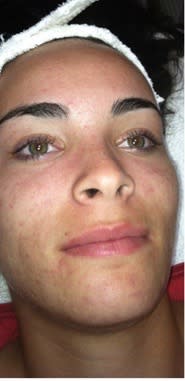
The Skinny
For those that deal with regular breakouts, the frustrations associated with acneic skin do not always clear up when the pimples do. Depending on the severity of the acne lesions, patients can be left with visible marks and scars that may or may not fade over time (check out our complete guide to Acne Scar Concerns). Happily, however, there are a host of professional and at-home treatment options to minimize the appearance of acne scarring.
AEDIT
Before & After Images by Provider









Before & After Images by Provider
Acne Scar Solutions
The Specifics
Who needs acne scar treatment?
Acne is the most common skin condition in the United States, impacting people from their teenage years through adulthood. While some breakouts clear up without a trace, acne lesions have the ability to damage the skin in the same way a traditional wound does, leaving behind permanent marks and scars.
There are two main classifications of scars-atrophic and hypertrophic-which develop as a result of how much collagen the body produces during the healing process.
Within those two classifications, there are more specific scar types (atrophic boxcar scars, ice pick scars, rolling scars, and hypertrophic keloid scars), and, just as there is an array of ways to treat active breakouts, there are many options for improving the appearance of acne scars as well.
The best way to determine what course of treatment is most appropriate for you and your scar type is to consult with an experienced board-certified dermatologist who can recommend both professional and over-the-counter remedies.
What can you expect from acne scar treatments?
Depending on a patient’s preference and scar type, there are both temporary and permanent procedures and treatments to correct acne scarring. A dermatologist can provide realistic expectations regarding what to expect from a particular approach, but remedies may range from skin-care products to laser resurfacing.
Certain procedures may come with a longer recovery time while others may just require you to apply a cream or gel once a day. Most treatments aim to exfoliate the skin and encourage the production of new collagen during the body’s healing process to replace scar tissue with new skin.
When should you seek treatment for acne scars?
While the answer is quite personal, many people choose to treat acne scars for physical, emotional, and social reasons. Individuals who previously suffered from severe acne may have had scarring during or after they received proper acne treatment. Although the acne may be gone, several dark marks and areas of scar tissue may remain. In addition to improving skin health, minimizing the appearance of acne scars can also improve confidence and self-esteem.
With that said, patients are often advised to clear up any active acne lesions or formations of new acne before working to correct scarring. The inflammation from current breakouts can interfere with the effectiveness of certain scar treatments.
Why should you seek treatment for acne scars?
Each individual’s skin type is as different as the severity of scarring that has occurred. Those with darker skin complexions may not have such noticeable scars compared to those with lighter skin. Some may have smaller scars that are barely visible while others have more noticeable scars.
The goal of acne scar treatments is to diminish the appearance of acne scars and dark spots, and to improve skin tone and texture. In-office procedures like dermabrasion and laser skin resurfacing can effectively reduce the visibility of acne scarring, while other treatments can help prevent future scarring.
Once you’ve decided to pursue acne scar treatment, there are a host of different procedures available depending on the type and severity of the scarring. Deep scars often require professional treatments to see results, while more superficial marks can be corrected with less aggressive, and even at-home approaches.
Cosmetic Procedures for Acne Scars
Dermatologists and plastic surgeons offer both invasive and noninvasive in-office procedures to treat acne scars. Many of these treatments can be combined, modified, and customized depending on the needs of the patient.
For Boxcar Scars
For Keloid Scars
For Ice Pick Scars
For Rolling Scars
At-Home Acne Scar Treatments
For patients with minimal acne-related scarring or for those looking to complement in-office procedures, there are several over-the-counter treatment options.
Over-the-Counter Skincare for Acne Scars
Similar to fighting active breakouts with products containing anti-bacterial and anti-inflammatory ingredients, there are products that can be incorporated into skincare routines to promote the healing and fading of acne marks and scars.
Antioxidants like vitamin C and vitamin E are known to promote collagen production. Additionally, acid-based (think: salicylic, lactic, mandelic, and glycolic) cleansers, serums, and toners can be used as chemical exfoliants to increase cell turnover. As a natural alternative, tea tree oil mimics the detoxifying qualities of salicylic acid, and may help to reduce the severity of breakouts, which may lessen minimize scarring long term.
Prescription Skincare for Acne Scars
A dermatologist may prescribe topical treatments, like a hydroquinone solution, to brighten the skin of those dealing with dark spots related to acne scarring or any kind of post-inflammatory hyperpigmentation (PIH).
Scar Creams and Gels
Over-the-counter formulas containing soothing ingredients like vitamin E and silicone can help to reduce the itch and discomfort associated with the wound healing process, as well as shrink, flatten, and fade raised acne scars. While creams and gels may be good options for reducing the scar size, they are unlikely to eliminate a scar completely.
The Takeaway
There are no two ways about it: acne scars can be frustrating. Fortunately, there are an array of professional and at-home treatment options that can address the causes, side-effects, and appearance of said scars. While it is common to experience a bit of downtime (think: pain, swelling, itching, and redness) in the aftermath of an acne scar treatment or procedure, working with a board-certified dermatologist can help you find the best way to combat acne scars safely and effectively to smooth and even your complexion.





